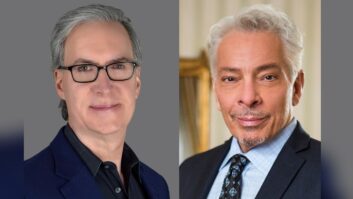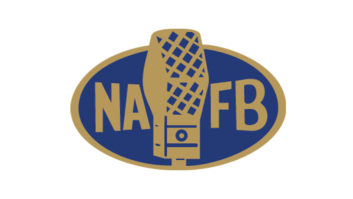Eugene McDonald was one of radio’s first great power brokers. He was an early broadcaster and the first president of the NAB; he built Zenith Radio Corp. into a manufacturing giant; was a pioneer in the development of shortwave, television and FM; and played a key role in radio’s licensing of ASCAP music and the creation of the Federal Radio Commission.

caption: Eugene F. McDonald Jr. (1886–1958) was president of Zenith Radio Corp. and the first president of the National Association of Broadcasters.
McDonald was born in Syracuse in 1888 and had soon made a fortune as one of the first to offer automobile financing. He joined the Navy in the First World War and rose to the rank of lieutenant commander.
In 1920, he heard his first radio broadcast and was fascinated. This led him to invest in a receiver manufacturer, Chicago Radio Labs. He became its general manager and created the “Z-nith” brand from the company’s amateur station call sign, 9ZN.
Zenith Radio Corp. quickly grew to become a major manufacturer under McDonald, who was known for his charismatic leadership and ruthless competitive spirit.
WJAZ, WSAX AND OTHER STATIONS
In August 1922, Zenith inaugurated its broadcast station, WJAZ, from elegant glass-enclosed studios in Chicago’s Edgewater Beach Hotel. Apparently dissatisfied with coverage and listener interference issues, Zenith sold WJAZ to the hotel in 1924, and it became WEBH (later merged with WDAP by the Chicago Tribune to become WGN).

caption: Zenith’s Chicago FM station W51C in 1940. It transmitted from the top of the Field building at 135 South La Salle St. on a frequency of 45.1 MHz. Zenith built the 5 kW driver and 50 kW water-cooled power amplifier. The FM modulator, at center nearest the window, was supplied by REL and the high-voltage power supply at far right came from Westinghouse. The antenna was a four-bay half-wave spaced crossed dipole with a gain of 3.0. The combo announcer’s control room was in this same transmitter room (visible far left).
However, Zenith reserved the WJAZ call sign and planned to build a new high-power station by the same name, with studios in the Zenith laboratories and a transmitter in suburban Mt. Prospect.
In the interim, Zenith operated a roving “portable” broadcast station, WSAX.
McDonald was a principal organizer of the 1925 MacMillan Arctic Expedition, and Zenith provided shortwave transmitters and receivers that kept the expedition team in regular contact with the US.
WJAZ broadcast family messages to members of the expedition each Saturday at midnight, and the expedition’s return messages were sent out using the Zenith shortwave transmitter. The project clearly demonstrated shortwave’s superiority for long-distance communication.
ASCAP
McDonald strongly opposed the payment of copyright royalties to ASCAP by broadcasters. (Yes, this is not a new issue!)

In 1923, McDonald joined with other commercial broadcasters to form the National Association of Broadcasters, and he became its first president. Their goal was to negotiate a better ASCAP rate schedule for radio. A second goal was to press for more uniform regulation of the radio spectrum than the weak 1912 Radio Act provided.
As the head of the NAB, McDonald was a natural target for ASCAP. WJAZ regularly broadcast the Edgewater Beach Hotel’s ballroom orchestra, and so ASCAP refused to renew the hotel’s performance license, unless it also took out a license for broadcasting. This became a test case that spawned a two-year unresolved battle in Congress. In the end, the NAB relented and negotiated a settlement with ASCAP that governed radio’s payment of royalties for over a decade.

caption: This QSL card from WJAZ, Zenith’s Chicago station, was issued in 1926.
CHALLENGING THE RADIO CZAR
In mid-1925, the new 5,000 watt WJAZ was ready to go on the air. But in the interim, the Chicago radio spectrum had become overcrowded, and WJAZ was ordered to share 930 kHz with KOA in Denver, allotted a mere two hours a week on Thursday nights.
Incensed, McDonald chafed at WJAZ’s frequency-sharing limitation, but in spite of weeks of pleadings and negotiations, Commerce Secretary Herbert Hoover refused to grant better operating conditions for the Zenith station.
McDonald publicly challenged Hoover’s authority and his “one-man control of radio,” calling him the self-appointed “radio czar.” Hoover held his ground and welcomed a “test case.” McDonald soon provided this to him with his unauthorized move of WJAZ to 910 kHz, a reserved Canadian channel.
In January 1926, the government took McDonald to court in a landmark case, United States v. Zenith, in which McDonald challenged Commerce’s authority to regulate the radio spectrum. In its April decision, the district court indeed ruled that, under the Radio Act of 1912 — written long before broadcasting had been contemplated — Commerce did not have the authority to assign frequencies or hours of operation or to deny a license to any applicant!
What followed was a two-year radio free-for-all, during which dozens of stations freely chose their own frequencies and transmitter powers, and Commerce was obliged to issue a license to any applicant. The extreme interference and the subsequent listener complaints this generated finally compelled Congress to replace the outmoded radio regulations.

caption: McDonald, right, shows off WJAZ’s curious “microspeakerphone,” a new Zenith radio invention, to Arctic explorer Donald MacMillan. The device was designed to combat the common problem of “mike fright” experienced by guest speakers and performers. Behind the grill cloth, the device displayed a moving image of an audience, to whom the speaker could direct his talk. When not used as a microphone, it doubled as a speaker.
THE BIRTH OF THE FRC
On Feb. 18, 1927, it passed the Radio Act of 1927. This created the new Federal Radio Commission, which was given the power and a congressional mandate to bring order to the radio spectrum. (With passage of the Communications Act of 1934, the FRC became today’s FCC).
Due to the controversy over this court case, McDonald stepped down from his role as president of the NAB, but he continued to be an active participant in the organization for many years.
Unfortunately for Zenith, the new FRC did not treat WJAZ kindly. It moved the station to the undesirable 1480 kHz frequency, where it shared time with WHT and WORD. Finally, in 1931, the FRC cancelled the licenses of all three stations, awarding the frequency to WCKY in Covington, Ky., which had pleaded that northern Kentucky was underserved by radio. (WCKY later abandoned Kentucky and moved to Cincinnati.)

caption: Zenith operated this portable broadcasting station, WSAX, from 1924 to 1926. The entire station was built on a one-ton truck chassis. It was self-contained and battery operated, with a 100-watt transmitter, generator and 53-foot telescoping antenna masts. The audio panel controlled three microphones with 300-foot extension cables, allowing the truck to be parked outside of auditoriums for live concerts and events. In 1925, it went on a nationwide tour of Zenith dealers, broadcasting from Pike’s Peak, Jack Dempsey’s training camp, Gay’s Lion Farm in California and dozens of small towns.
BACK TO BROADCASTING
McDonald and Zenith stayed out of broadcasting for eight years, concentrating on the radio receiver business, but they returned to broadcasting in 1939 with the construction of two experimental stations.
The first was W9XZV, the first Chicago television station using the new all-electronic standard, which operated on Channel 1 until 1953.
The second was W9XZN, one of the country’s first experimental FM stations. In 1940, it became W51C, equipped with a 50,000 watt custom-built transmitter and boasting a 100-mile coverage radius. It broadcast 16 hours daily at 45.1 MHz in the old FM band playing “only good music” from specialized high-fidelity transcription discs, ranging from classical and Latin music, to Gilbert and Sullivan. W51C’s only advertising was one announcement each hour promoting Zenith products. Program guides were sold to the public on a subscription basis. When W51C moved to the present FM band, it became WEFM, which stood for “Eugene F. McDonald.”
In the 1970s, Zenith sold WEFM to General Cinema Corp., and it is today known as WUSN.
Under Eugene McDonald, Zenith grew into a major radio manufacturer in the 1940s and began producing television sets in 1948. His many contributions to radio helped shaped the industry we know today. “Commander” Eugene F. McDonald Jr. died in Chicago in 1958. In 1967, McDonald was posthumously inducted into Broadcast Pioneers Hall of Fame.
Read more of John Schneider’s history articles atradioworld.com, keyword “Schneider.”






